Tughlaqabad Fort- of Myths and Curses
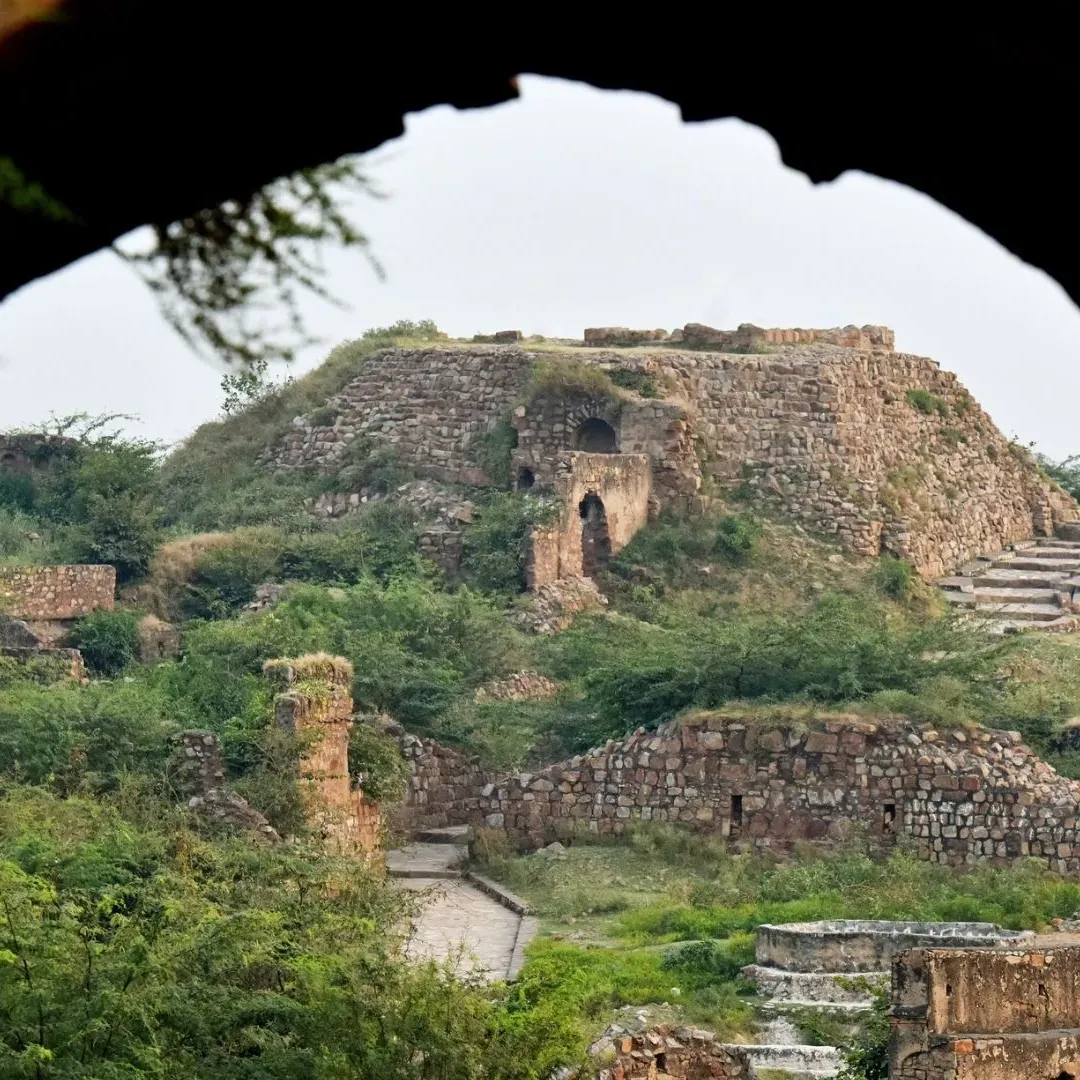
The Tughlaqabad Fort is a magnificent architectural marvel located in the hustle and bustle of Delhi and stands proud as a living reminder of the reign the Tughlaq dynasty. Constructed in the 14th century by Ghiyas-ud-din Tughlaq, the founder of the dynasty, this imposing fortress tell the story of his ambitions and how that led to his rise and then, eventual fall.
History
It would not be hyperbole to say that the history of the Tughlaqabad Fort is in fact deeply intertwined with the rise and fall of the Tughlaq dynasty. Ghiyas-ud-din-Tughlaq, or Ghazi Malik as he was known back then, was a vassal of the Khilji Dynasty. He had been crucial to the protection of the empire against Mongol invaders as the Warden of Marches.
One day, while on a walk with the then ruler and the nephew of Alauddin Khilji, Khusrau Khan, he floated the suggestion of building a fort on a hill in Southern Delhi. Khusrau dismissed him rather hastily, instead telling him that he can build one himself if he ever becomes the ruler one day. Unbeknownst to him, Khusrau had planted the seeds of his own downfall. In 1321, Ghazi usurped the throne from Khusrau Khan and spelled the end of the Khilji dynasty; he changed his own name to Ghiyas-ud-din-Tughlaq and thus began the Tughlaq dynasty brief tryst with the Indian subcontinent.
Upon ascending the throne, he sought to establish his authority and protect his kingdom from external threats. In the year of his ascension itself, he commenced the construction of the Tughlaqabad fort, envisioning it as a stronghold to safeguard Delhi against Mongol invasions, which had been a recurring menace during that era.
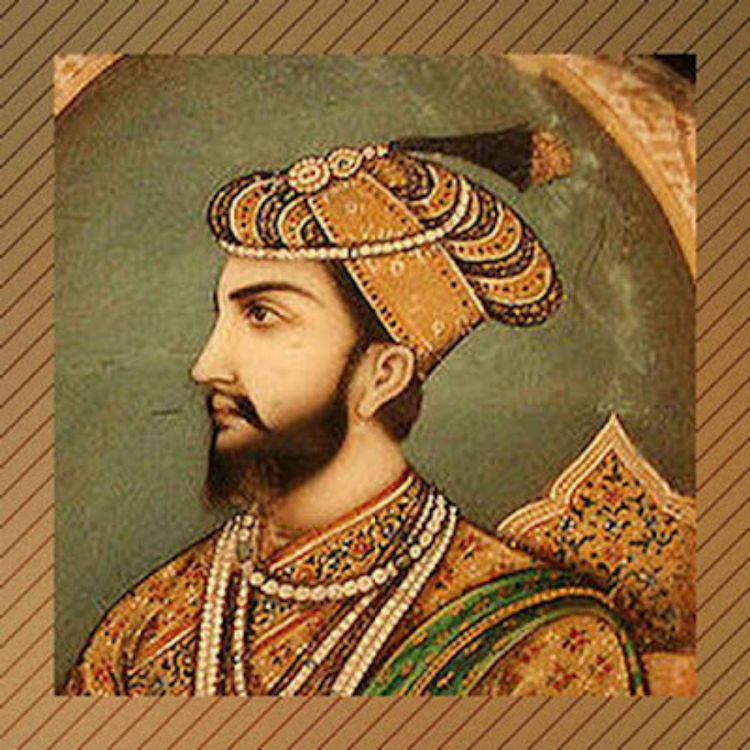
The fort was strategically situated atop a rocky hill, offering a commanding view of the surrounding plains. Its construction was a testament to the engineering ingenuity of its builders, who employed massive stone blocks to erect formidable walls and imposing structures. The layout of the fort was meticulously planned, with bastions strategically positioned along the walls to provide defense against potential attackers.
Tughlaqabad Fort was not only a symbol of military strength but also served as the administrative and political center of the Tughlaq dynasty. Within its confines, the royal court convened, administrative affairs were managed, and barracks were provided for soldiers.
Despite its initial grandeur, the fortunes of Tughlaqabad Fort took a dramatic turn following the death of Ghiyas-ud-din Tughlaq. Neglect and mismanagement by subsequent rulers led to the gradual decline of the fort, culminating in its abandonment and eventual ruin.
Nizamuddin Auliya's Curse:
One of the most intriguing aspects of Tughlaqabad Fort's history is the legend surrounding Nizamuddin Auliya's curse. Nizamuddin Auliya, a revered Sufi saint of the Chishti order, is said to have cursed the fort and its founder, Ghiyas-ud-din Tughlaq, due to the forced labor and hardship endured by the local populace during its construction.
In order to get the work on the fort completed as soon as possible, Ghiyas-ud-din-Tughlaq forced every single labourer in Delhi to abandon other work and put in long hours to see its construction through. This led to a halt on the construction of a well that Nizamuddin Auliya was getting built, and he was also concerned about the conditions of the work that the labourers were forced to put in. Tughlaq also imposed a ban on oil for Nizamuddin Auliya, so as to prevent lamps from being lit at the site.
Legend has it that Nizamuddin Auliya thus prophesied that the fort would remain uninhabited and bring misfortune to its inhabitants. He uttered the famous words, "Ya rahe ujar, ya base gujar" (May it remain unpopulated, or inhabited by nomads), symbolizing the desolation that would befall the fort.
During Tughlaq's campaign in Bengal, he found out that few labourers had abandoned work on the fort in order to work on Nizamuddin's baoli, which greatly angered him and he took a vow to teach the saint a lesson. Nizamuddin Auliya muttered yet another curse- "Hunuz Dilli dur ast,", i.e., "Delhi is still far away."
As fate (or Nizamuddin) would have it, Tughlaq died on his way back. There are various accounts of his death- some believe that his eldest son, Muhammad Bin Tughlaq ordered for his tent to be collapsed on him, while some believe that a pavilion erected to celebrate Ghiyas-ud-din collapsed, killing him and his youngest son.
Whatever the cause of his death, the curse is believed to have cast a shadow over the fortunes of Tughlaqabad Fort, contributing to its eventual decline and abandonment. While historians debate the veracity of the legend, the story of Nizamuddin Auliya's curse continues to capture the imagination of visitors and enthusiasts alike, adding a layer of mystique to the fort's storied past.
Architectural Features

Massive Walls
The most striking feature of Tughlaqabad Fort is its massive walls, constructed using large stone blocks. These walls, towering high and thick, served as a formidable barrier against invaders. The sheer scale of the walls is a testament to the architectural prowess of the builders.
Bastions
Bastions were strategically positioned along the walls of the fort, providing vantage points for archers and defenders to repel attackers. These fortified structures played a crucial role in the defense of the fort and contributed to its overall architectural design.
Layout
The layout of Tughlaqabad Fort follows a geometric pattern, typical of Tughlaq architecture. The fortification is divided into several sections, each serving a specific purpose, including administrative offices, barracks, and residential quarters.
Defensive Features:
The fort was designed with robust defensive features, including ramparts, moats, and watchtowers. These elements were strategically integrated into the fort's architecture to enhance its defensive capabilities and thwart potential attacks.
Tughlaqabad Darwaza:
The entrance to the fort, known as the Tughlaqabad Darwaza, is an imposing structure adorned with intricate carvings and decorative motifs. The Tughlaqabad Darwaza is renowned for its sheer size and architectural splendor. Rising to an impressive height, it commands attention and instills a sense of awe in all who behold it. The facade of the Tughlaqabad Darwaza is adorned with intricate carvings, decorative motifs, and ornamental details. Constructed using sturdy materials such as stone and mortar, the Tughlaqabad Darwaza was built to withstand the test of time.
It serves as a potent symbol of the Tughlaq dynasty's authority and grandeur. As the primary entrance to Tughlaqabad Fort, it functioned as a ceremonial gateway through which kings and dignitaries would pass, symbolizing their status and prestige. Beyond its symbolic significance, the Tughlaqabad Darwaza held strategic importance from a defensive standpoint. Positioned at the entrance of the fort, it served as a formidable barrier against potential invaders, deterring any who dared to challenge the might of the Tughlaq dynasty.
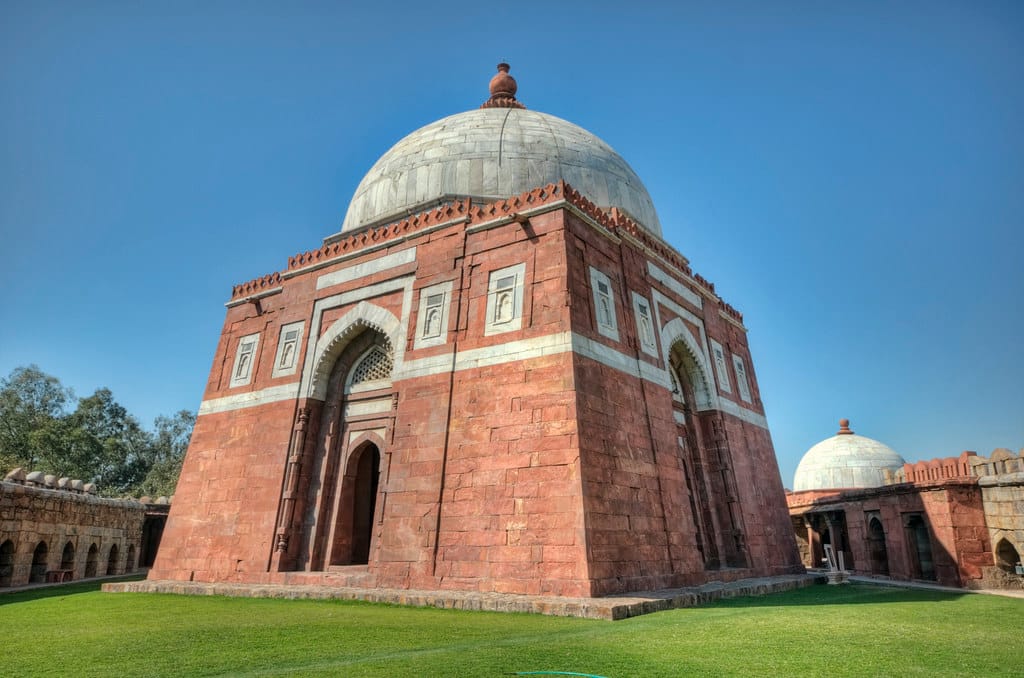
Mausoleum of Ghiyas ud-Din Tughluq
The Mausoleum of Ghiyas ud-Din Tughluq is designed in an octagonal shape, a common architectural feature of Islamic tombs during that era. Atop the mausoleum sits a majestic dome, rising to a considerable height. The dome is a prominent feature of Islamic architecture, symbolizing the heavens
The exterior walls of the mausoleum are adorned with intricate carvings that serve as a solemn tribute to Ghiyas ud-Din Tughluq, commemorating his contributions as the founder of the Tughlaq dynasty. The mausoleum is connected to the fort in the southern direction and it stands as a testament to his legacy and enduring influence on the history of Delhi.
Amidst its architectural splendor lies a tale of ambition, conquest, and ultimately, decline. The legend of Nizamuddin Auliya's curse serves as a poignant reminder of the human cost and spiritual implications of empire-building.
Today, Tughlaqabad Fort stands as a silent witness to the passage of time, its weathered walls and crumbling structures bearing witness to centuries of history and upheaval. As visitors explore its many passages and towering ramparts, they are transported back in time, to an era of kings and conquerors, where the fate of nations was decided amidst the echoing whispers of the past.
Nearby Attractions
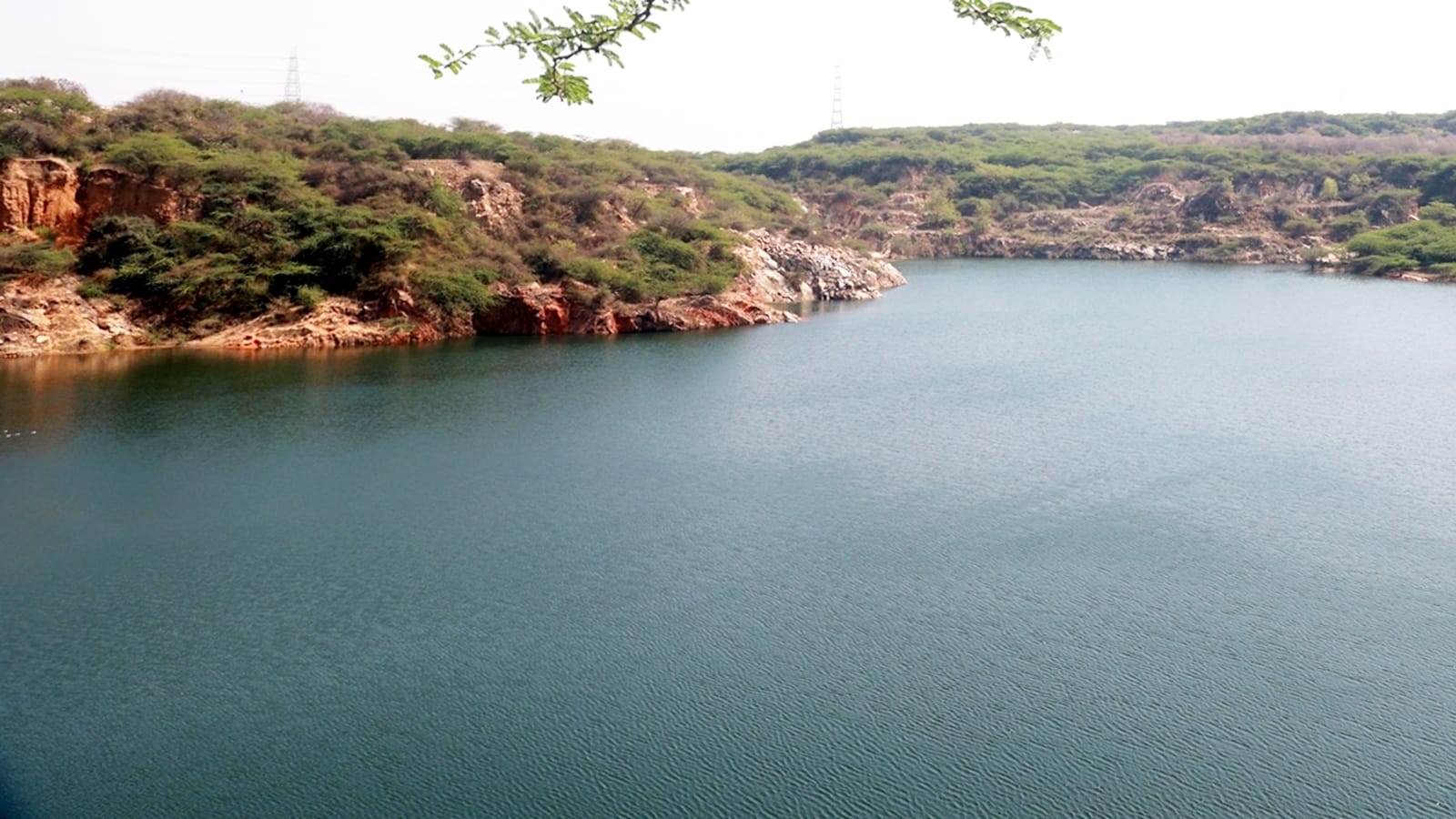
Asola Bhatti Wildlife Sanctuary
Asola Bhatti Wildlife Sanctuary, also known as Asola Hariyali Park, is a natural sanctuary that spans an area of approximately 32.71 square kilometers. It is renowned for its rich botanical diversity, encompassing a variety of ecosystems such as dry deciduous forests, scrublands, grasslands, and rocky terrain. The sanctuary is home to a plethora of plant species, including Dhau, Dhak, Kair, Ber, Babool, and several species of grasses and herbs. On the fauna front, common sights include Nilgai, Indian Hare, Indian Porcupine, Jungle Cat, and Indian Grey Mongoose. Avian species such as Painted Stork, Black Kite, Indian Peafowl, and various migratory birds can also be spotted in the sanctuary.
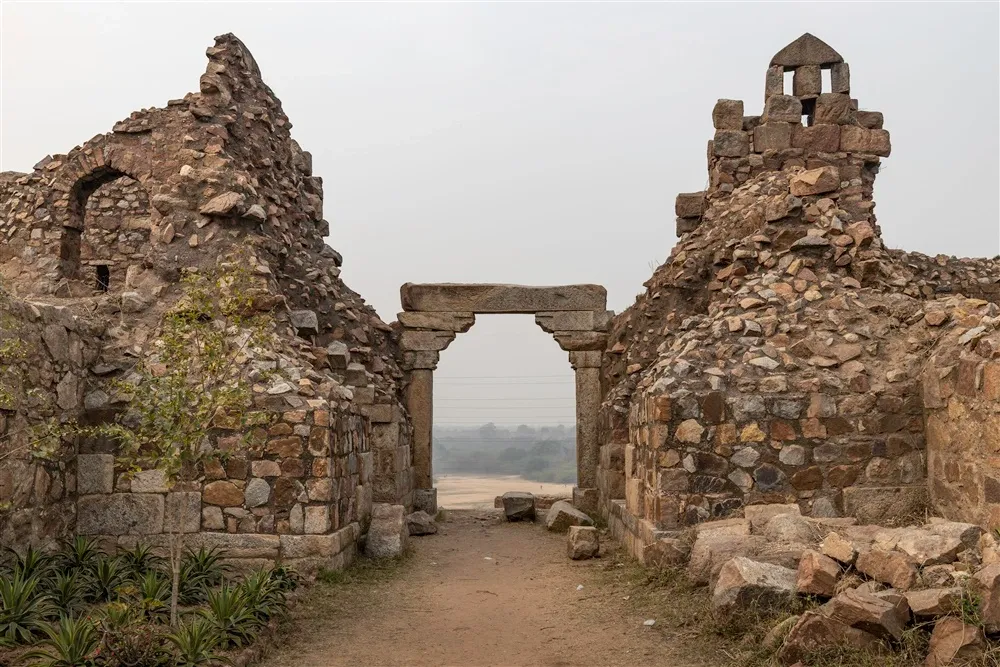
Adilabad Fort
Adilabad Fort, located in Tughlaqabad, Delhi, India, is yet another historic fortress built during the Tughlaq dynasty's reign in the 14th century by Ghiyas-ud-din Tughlaq around the same time as the Tughlaqabad Fort. Its location along major trade routes contributed to its military and economic significance. In recent years, efforts have been made to preserve and restore Adilabad Fort as part of Delhi's cultural heritage. Conservation projects aim to safeguard the fort's architectural integrity and promote awareness of its historical significance among visitors and locals alike.
Qila Rai Pithora Fort
Qila Rai Pithora, also known as Lal Kot, is a historic fortification in Delhi, India, dating back to the 12th century. Initially constructed by Chauhan king, Prithviraj Chauhan, it was later expanded by Sultan Muhammad bin Sam of the Slave Dynasty. The fortification encompasses an area of about 6 km and served as the capital of the Delhi Sultanate during the early medieval period. Though largely in ruins today, its remnants offer glimpses of its former grandeur, including bastions, gates, and fort walls.
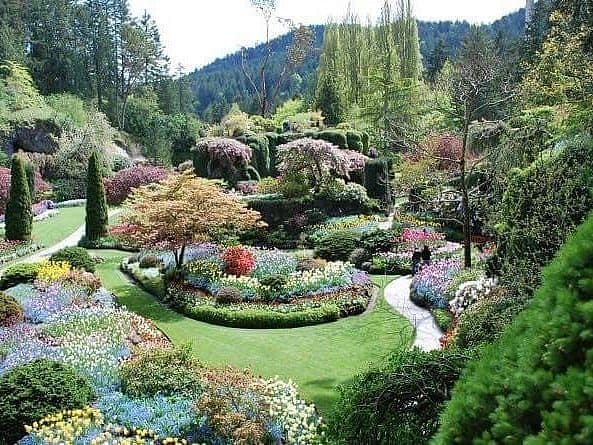
Garden of Five Senses
The Garden of Five Senses, situated in New Delhi, India, is spread across 20 acres and designed to stimulate the senses and offer a serene escape from urban life. Opened in 2003, it features lush gardens, vibrant flower beds, aromatic herb gardens, cascading waterfalls, and meandering pathways. Visitors can engage in various activities like leisurely walks, picnics, photography, and cultural events. The garden also hosts art installations, food festivals, and musical performances, making it a hub of cultural and recreational activities. With its blend of natural beauty and artistic elements, the Garden of Five Senses is truly a delight for all the five senses.
Food Near Tughlaqabad Fort
Dadu Cutlet Shop, CR Park
Dadu Cutlet Shop, located in CR Park (Chittaranjan Park), is a renowned culinary destination in South Delhi, India, celebrated for its delectable assortment of cutlets and snacks. Situated amidst the vibrant market of CR Park, this eatery has earned a reputation for its mouthwatering cutlets such as aloo, fish, mutton, chicken and paneer and fast-food offerings that range from crispy samosas to tangy golgappas and spicy chaat, there's something to satisfy every craving at Dadu Cutlet Shop. It also benefits from the vibrant atmosphere of one of Delhi's most culturally rich neighborhoods.
Lajawaab Chaat and Vada Pav Corner Kalkaji
"Lajawaab Chaat and Vadapav Corner" in Kalkaji, Delhi, is a popular street food joint known for its delectable assortment of chaat and vadapav, two iconic Indian snacks that are beloved across the country. It is known for its diverse range of chaat items which included aloo tikki, papdi chaat and a delightful bhelpuri. Their servings of Vada Pavs too are worth a shot and loyal to the original variant served in Maharashtra.

Lebanese Point, Saket
"Lebanese Point" in Saket, Delhi, is a popular dining destination known for its authentic Lebanese cuisine. In Delhi, it is one of the only places that serves Shawarma with pita bread, tahini sauce and pickles, which is how it is meant to be, rather than the Indianised version that is often found in the streets of Delhi.
Ways to Reach Tughlaqabad Fort
Tughlaqabad Fort is located in Delhi, India, and can be reached by various modes of transportation. Unlike a lot of other attractions in Delhi, one of the most convenient ways to reach Tughlaqabad Fort is by car, taxis or autos. Visitors can hire a taxi or use ride-hailing services to reach the fort directly. The fort is well-connected by roads, and there is ample parking available near the entrance.
Delhi Metro is a lifesaver yet again- The nearest metro station to the fort is Tughlakabad Metro Station, which is located on the Violet Line of the Delhi Metro. From the metro station, visitors can take a short auto-rickshaw ride or if time and health allows them, a short walk to reach the fort. Delhi Transport Corporation (DTC) operates several bus routes that pass near Tughlaqabad Fort- 34, 34A, 202D, 356LNKSTL, 419STL., 434, 525, 525STL, 544, 548EXT, 717, 717A, 717ALNKSTL and 717B. Finally, some tour operators in Delhi offer guided tours that include visits to historical sites like Tughlaqabad Fort. Tourists can opt for these guided tours, which often provide transportation and informative commentary about the fort and its history.
Regardless of the mode of transportation chosen, visitors to Tughlaqabad Fort should plan their visit during daylight hours and consider the weather conditions, especially during the summer months, as Delhi can experience extreme heat. Additionally, it's advisable to carry sufficient water, sunscreen, and comfortable walking shoes for exploring the fort.
Timings and Ticket Prices
Tughlaqabad Fort is generally open to visitors from 7AM to 5PM and can be visited most days of the week, barring special circumstances. Entry to Tughlaqabad Fort is INR 5 for Indian citizens and INR 100 for foreign nationals. Visitors may need to pay a nominal fee for parking if they arrive by private vehicles. It's advisable to visit the fort during daylight hours, as it may not be well-lit after sunset.

Comments ()